Everyone has heard of the Black Death and how it devastated Europe in the Middle Ages. What you might not know is there was an equally deadly outbreak of bubonic plague in the late 19th century/early 20th century, or that plague is still active around the world today. "Bubonic Panic" is the final book in Gail Jarrow's deadly diseases series. She started with "Red Madness: How a Medical Mystery Changed What We Eat" and followed it up with "Fatal Fever: Tracking Down Typhoid Mary." "Bubonic Panic" details the history of the bubonic plague and specifically focuses on the third wave of plague that hit the world in the early 1900s.
The third pandemic of bubonic plague began in China and quickly swept through the Far East and India. Doctors and researchers from around the world converged on Hong Kong and other epicenters of the disease to find out what they could about the causes and how it spread. Alexandre Yersin was the first researcher to correctly identify the bacteria causing bubonic plague, and in 1894, Yersinia pestis was named in his honor. Two other researchers, Simond and Ogata, each identified the path of the disease when they realized plague was carried from fleas on infected rats who bit humans. Unfortunately, their research wasn't widely known or even believed for years. During this time period, most doctors and public health officials believed the best way to contain the plague outbreaks was to disinfect, isolate and quarantine.
America had been plague-free until an outbreak hit Honolulu in 1900. It was centered around Chinatown, and many believed it was caused by unsanitary conditions in that district. It was a small outbreak but resulted in the almost complete destruction of Chinatown by an out-of-control fire. Plague wasn't done with America yet, however. A few months after the Honolulu outbreak, plague was in San Francisco. It was again centered around Chinatown. Through a series of political missteps, the San Francisco outbreak became a hot-button issue. Many people, including the governor of California, did not believe bubonic plague actually existed in San Francisco. They blamed the Marine Hospital Service, today the Public Health Service, and its leader in San Francisco, Dr. Joseph Kinyoun. Failed quarantines and public relations disasters lead to the ousting of Kinyoun and eventually Gov. Gage, but it did not stop the spread of plague. The San Francisco earthquake of 1906 further hindered efforts to stop its spread. It took the leadership of Dr. Rupert Blue and the eradication of millions of rats to finally slow the disease.
It is surprising to most that bubonic plague has never actually been eradicated. The fleas that carried the disease spread into the wild and infected other rodents, like ground squirrels. Plague continues infecting and killing people throughout the world today. In America, it is centered around the Southwest, but fortunately antibiotics can be used to treat plague if caught early enough.
Gail Jarrow is a master at writing nonfiction that reads like a thriller. "Bubonic Panic" is a fascinating look at a deadly disease with the history and potential to cause major harm. Jarrow makes the story of this disease come alive in how she tracks its progress around the world, introduces those working to stop its spread and reveals the contradictory responses by public officials. The narrative style and quality illustrations draw readers into the story and make history come alive.
Angie Bayne is the Children's Services Manager at Missouri River Regional Library.

